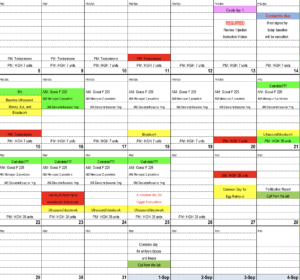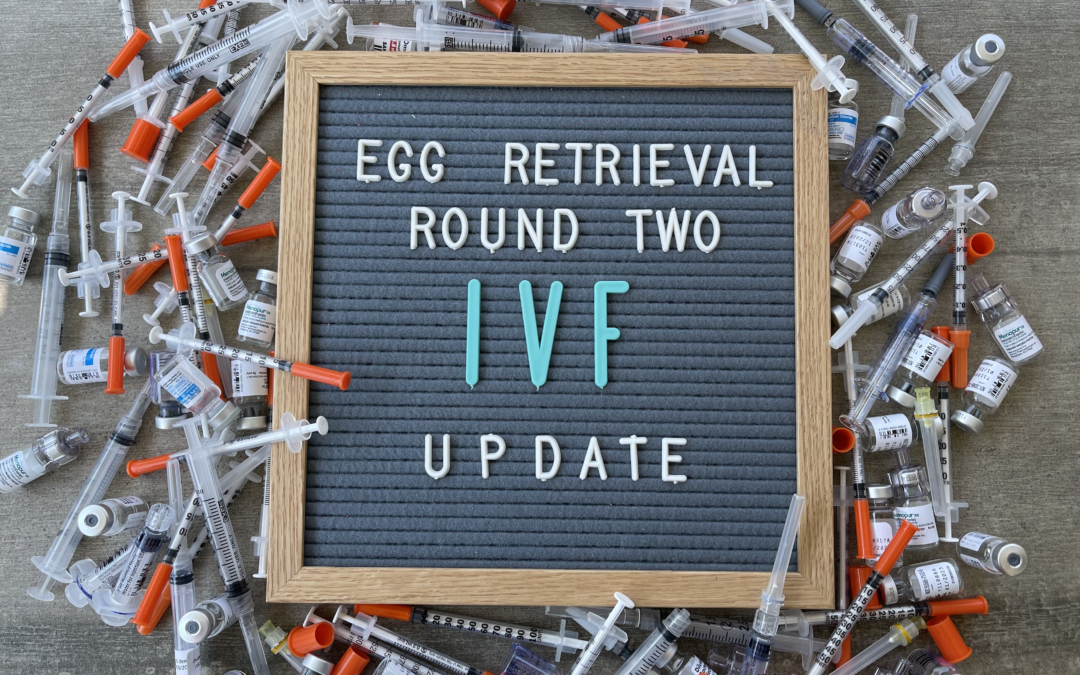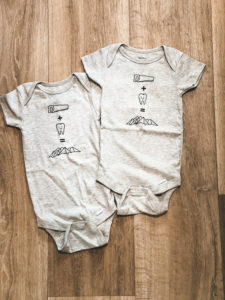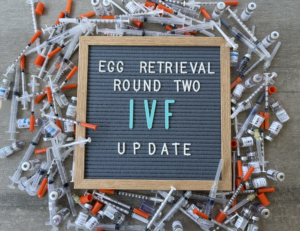A breakdown of IVF Cycle #2
They say that insanity is doing the same thing over and over again and expecting different results. I couldn’t agree more (obviously), which is why after our first round of IVF failing, I am going to share how many adjustments we made to get a different outcome, hopefully.
The changes made to medications and dosage were decided by my doctor and are specific to my infertility case. Travis Zipper recommended the supplemental, lifestyle, and mindset changes and some from my research.
The prime phase:
- We did not start with birth control this time around. We waited for my natural cycle to start and had my baseline appointment on cycle day 2.
- We added in daily supplementation of human growth hormone for 30 days before egg retrieval to support and increase egg quality (injected subcutaneously in my abdomen)
- We added small amounts of testosterone daily for 14 days before starting the stimulation meds to support and increase egg quality.
- For the past 90 days, I’ve been supplementing with the following:
Ubiquinol C0q10 – to increase energy production in mitochondria to support egg development and quality (one of the most effective supplements to support the production of chromosomally normal and viable eggs)
Vitamin E – An antioxidant that can benefit egg quality
NAC – an antioxidant shown to benefit egg quality and fertility and boosts glutathione activity in the cell
R Alpha Lipoic Acid – an antioxidant that may benefit egg quality and support the cells ability to recycle and use vitamin C, E, and CoQ10 back into their active antioxidant form. It also helps increase glutathione
Probiotics – a specific strain that helps recover from the use of antibiotics
Lots of Vitamin C – an antioxidant to support ovarian function and quality of eggs
Lots of Vitamin D – Increased fertility and increased fertilization rates
Methyl Folate – shown to increase IVF success rates and improve egg quality
Prenatal – to support crucial vitamins and minerals
Glutathione – to help support detoxification
Melatonin – to lower oxidative stress and damage to ovarian follicles support egg development and quality
Just to name a few 😉
I have continued with those supplements throughout the stim phase and will keep up with them until further notice about the success of this egg retrieval.
Lifestyle and diet factors I’ve changed throughout the prime and stim phase:
- My diet has been 95% organic produce and high-quality meats
- Increased fatty acid intake
- Increased antioxidant intake
- We added air purifiers throughout the house to reduce pollution and toxins in the air
- I swapped out all of our cleaning supplies with toxin and chemical-free products (Seventh Generation brand)
- Eliminated all household scents
- Reduced personal cosmetic use
- Swapped out all soap and lotions for chemical and toxin-free brands
- Swapped out our coffee maker to a glass/stainless steel pour-over to reduce exposure to hot plastic
- Reduced caffeine intake to <100mg/day (most days)
- Swapped all coffee products to organic blends (I use 3/4 organic decaf and 1/4 organic french roast from Thrive Market)
- Reduced sugar intake and focused on more balanced meals to support blood sugar
- Added digestive enzymes to all meals
- Avoided alcohol (I had some wine or hard kombucha on occasion)
- I’ve kept intensity and volume relatively low for workouts. No more than 60 mins/day 5 days/week
- 8-10k step minimum
- 8-9 hours of quality sleep
- Positive thoughts and affirmations
- Visualization with starting a family
I’m sure there’s more that seem more of a habit and routine at this point.
Stimulation Phase:
I attached a photo of my stim meds calendar so you could get an idea of how much goes into this.
The most significant change we made here as far as medications go is the increase in the gonal-f and the addition of dexamethasone. The increase of gonal-f was to help stimulate the follicles and help the eggs develop and mature. The steroid, dexamethasone, was primarily for egg quality. We also only triggered with lupron this time and left out the hCG in hopes of an easier recovery post egg retrieval.
We started the cetrotide earlier than we did in cycle one because of my follicle size on day 6. Once you have a lead follicle that exceeds 18mm they want you to add the cetrotide (another SQ injection) in to prevent your body from ovulating but still allow the rest of your follicles to grow.
The stimulation phase has been pretty comparable to round one, except for a little more bloating and some extreme energy dips, and insomnia due to the steroid.
We have been closely watching my follicle size and estrogen levels with back-to-back appointments for ultrasounds and bloodwork for the past five days. In the world of infertility, they call the ultrasound Wanda, and you become very familiar with her throughout this process. Based on my estrogen levels on Monday, they had me discontinue the gonal-f. With the direction my levels were headed, I was at risk for hyperstimulation again. Yesterday, I had more than eight follicles on the left side at or above 18mm, five on the right side at or above 18mm, and plenty more on both sides measured in the teens, which can still develop a viable egg. Based on the ultrasound, the nurse was pretty confident that I would be doing my trigger shot a day early, but we needed to confirm with labs, which they did and sent me trigger instructions right away.
Last night, we triggered with Lupron only since I had complications with the hCG last time. The trigger shot stimulated the surge of LH (luteinizing hormone), which promotes meiotic egg maturation and finally allows your body to ovulate all of the eggs you have been stimulated to overproduce.
The trigger shot is one of the most important timed shot throughout your IVF cycle because they schedule your procedure exactly 36 hours after. Once you trigger, they have you discontinue all other medications and have your blood tested again to ensure LH levels are greater than 14.
Egg retrieval is a minor surgery. There is no food or water 8 hours prior, and I’ll be under anesthesia for about 20-30 mins while they harvest the eggs. They will know how many they retrieved almost immediately, and the next steps beyond that will be to fertilize and start waiting to see how many will thrive.
Next week, I’ll stay in touch and update you once I have more information and hopefully good news.
Lastly, I just want to acknowledge that a big reason for all of the changes I chose to make this time around had so much to do with the knowledge and support from my dear friend and mentor, Travis Zipper. We learned of his sudden and unfortunate passing less than a week ago, on August 19th. My heart hurts knowing how passionate he was about helping me succeed with this journey and all of our plans to share this knowledge with others in similar situations trying to start a family. I know that he will still somehow find a way to help me and others. I’m so incredibly grateful to have learned so much from him and be a small part of his passion for changing the world of infertility. Travis, you are so missed, and your impact is so huge. Thank you.

![]()




